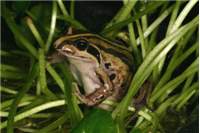Family
Myobatrachidae
Genus
Lymnodynastes
Species
peronii
Threats/Control Methods - Local
Within the A.C.T the largest threat to the species is the loss of habitat through urbanisation with the grasslands that provide their habitat also seen as suitable building sites. Despite not currently being considered at risk, care should be taken at all times when entering frog habitats due to the risk of spreading disease, including the Chytrid fungus (chytridiomycosis). To prevent the spread of the Chytrid fungus it is important to wash your shoes before entering, AND after leaving frog habitats. For more information go to http://www.deh.gov/biodiversity/invasive/publications/c-disease/
Local/Urban Actions
You can encourage frogs into your own backyard by including habitat features in your garden. The Ginninderra Catchment Group, Australian National University and Environment ACT have developed a guideline to help you encourage frogs into your backyard called Creating a Frog Friendly Habitat in the ACT Community.
You can also get involved in monitoring local frog populations. Frogwatch is an annual program run to monitor the presence and abundance of frogs within the ACT region. The Frogwatch program provides training for community volunteers each October, with monitoring then being undertaken by volunteers over a two week period.
For more information on Frogwatch contact:The ACT Frogwatch Coordinator, Ginninderra Catchment Group; Ph (02) 6278 3309 or email: [email protected]
Distinguishing Features
Ranging from 4.5 -7.5cm in length this species has a dark brown to grey back, often with longitudinal dark and light-brown stripes running from the head to the tail; a pale raised stripe runs from below the eye to the top of the forearm. Tadpoles are light brown to black in colour, they can reach 8.5cm in length and are often found dwelling on the bottom of the pond or waterbody.
Common name/s
Striped Marsh Frog, Brown-striped Frog, Peron's Marsh Frog, Brown Frog
Similar Species
Although similar to L. tasmaniensis in appearance the two can be distinguished by their calls; L. tasmaniensis has a call resembling ©kuk uk uk© while the call of L. peronii call is a single repeated ©toc© or ©pop© sound; or the presence of stripes running the length of the back are characteristic of L. peronii alone.
Distribution
Occurs along most of the eastern edge of Australia, from Queensland through to Victoria, and along the southern coast from Victoria to the bottom south-east corner of South Australia. Also found in the northern regions of Tasmania.
Country of Origin
Australia
Survey Techniques
The most common technique for monitoring frog populations is based on call identification, with each frog species having a unique call. Frogs should not be handled without the use of sterile gloves, as their skin is very sensitive to chemicals, including soap and sunscreen. For more information see Local Actions below.
Conservation (Pet/Pest) Status - National
Not at risk. Population thought to be stable or increasing.
Conservation (Pet/Pest) Status - Regional
Not at risk. The A.C.T is thought to be the western-most limit of the species, where populations are limited to appropriate habitats.
LSCCES Population
In the 2004 Frog watch Survey of the ACT Limnodynastes peronii was not detected, although it is present in low numbers within the region, and has been recorded in previous surveys.
Associated Vegetation Community
Open perennial grasslands in low-lying areas near still bodies of water.
Limiting Resources
Requires shelter, such as logs, rocks or reeds, to hide under during the day.
Breeding
Calls all year round, with breeding occurring from late spring through to summer. Eggs are laid in a floating foam nest of up to 1000 eggs.
Behaviour
Males call from the waters edge or while floating in the water.
Functional Group
Insectivorous
Food Species
Small invertebrates
Predators
May include native birds, such as the White-Faced Heron (Egretta novaehollandiae) and Intermediate Egret, and fish, including the introduced Carp, Goldfish and Trout. Introduced species such as Cats (Felis catus) and Foxes may also predate on frogs.
Interesting Fact
Along with its relation L. tasmaniensis this species will often be one of the first to quickly colonise new backyard ponds.
References - (reader suitability of references, P=Primary teachers, S=Secondary students, T=Tertiary students and researchers)
Books:
Barker, J., Grigg,G., Tyler, M. (1995). A Field Guide to Australian Frogs. Surry Beatty & Sons. NSW, Australia. S, TLintermans,M. & Osborne, W. (2002). Wet & Wild: A Field Guide to the Freshwater Animals of the Southern Tablelands and High Country of the ACT and NSW. Environment ACT. Canberra, Australia. S, TRobinson, M. (1993). A Field Guide to Frogs of Australia. Australian Museum/Reed books. NSW, Australia. S, TSwan, G.(2001). Green Guide: Frogs of Australia. New Holland Publishers. Sydney, Australia. P, S
Online Publications:
Amphibian Research Centre. (2005). Available Online: http://frogs.org.au/frogs/species/Lymnodynastes/peroni/ S, TAustralian Frogs Database.(2005). Available Online: http://frogsaustralia.net.au/frogs/display.cfm?frog_id=40 S, TDepartment of Environment and Heritage, (2004). Chytridiomycosis Factsheet http://www.deh.gov.au/biodiversity/invasive/publications/c-disease/ S, TZoological Parks and Gardens Board. Frog Pond Checklist. Available Online: http://www.zoo.org.au/education/factsheets/amp-frog_pond_checklist.pdf P, S, TZoological Parks Board N>S>W. (2005.). ASX Frog Focus. Available online: http://www.asxfrogfocus.com/ P, S (School activity program)Speare, R et al (1998). HOW TO REDUCE THE RISKS OF YOU TRANSMITTING AN INFECTIOUS AGENT BETWEEN FROGS AND BETWEEN SITES. Available Online: http://www.jcu.edu.au/school/phtm/PHTM/frogs/prevent.htm S, T
Researcher: Pippa Jaminon



 Top
Top Top
Top